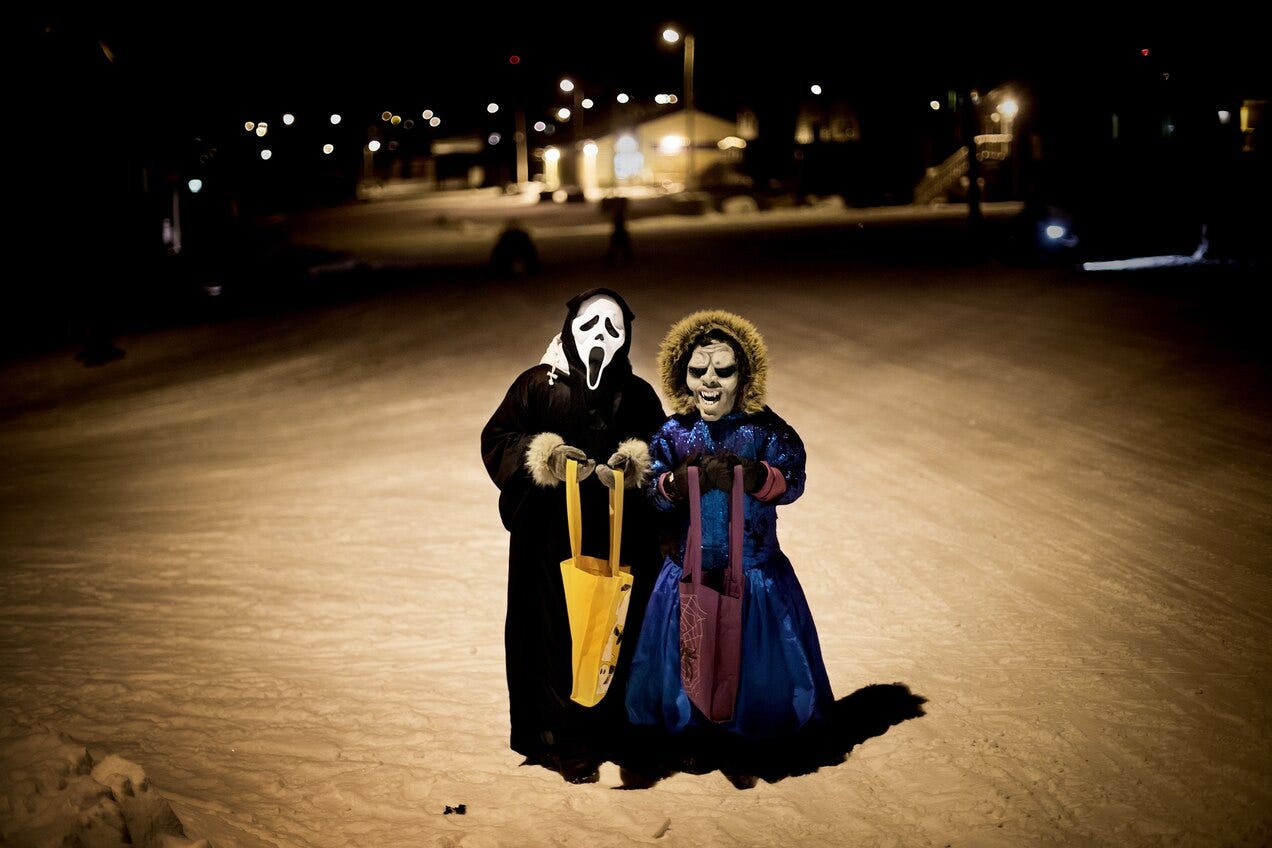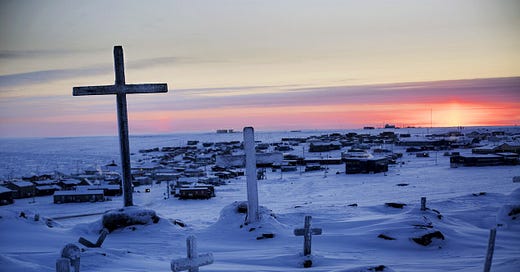I generally find that great things happen when you fuck around on Google Maps for two or three hours at a time. The other day I started in Bozeman, Montana and gradually wandered northeast, making my way through Canada’s Northwest Territories and from there into Nunavut, home to primarily Inuit people as well as the world’s northernmost permanently inhabited place. (Which would be Alert, population sixty-something.) I drifted up the Hudson Bay and into the Arctic Archipelago, looking for little villages to click on, when I saw the pin for the Co-op Restaurant. It was the only business — in fact the only anything — that showed up at such a zoomed-out viewpoint, more prominent even than most surrounding towns. I had to know the deal!
The Co-op Restaurant does not have a website, but it does have 106 Google reviews. It quickly became apparent that just about all of them were from people like me, bored and on Google Maps, seeing what all went on way up there. They mostly go something like this: “Woww I don’t know what to say human kind is way out there Respect for you guys”; “Quite surprised to find a civilization here. Greetings from Malaysia!”; “Love from Dallas, Texas. Why am I here? I have no freaking idea.” (A small handful of early reviewers had actually dined at the Co-op: “Woman behind counter smokes. But the pizza is okay.”) There is also a note from a woman claiming to own the restaurant, thanking everyone for the kind words, though upon further investigation, she is almost certainly lying. Such is the irresistible draw of the Co-op, which, as it turns out, is one of two restaurants on the island of Igloolik, population 1,682. Or rather, it was!
Let me tell you some things I have learned about Igloolik, whose name translates in Inuktitut to “there is a house here.” It is 1,200 miles from the North Pole, and during winter, the temperature averages -30°C; in summer, the sun won’t set for months. The community’s elders grew up sleeping in igloos or tents, eating caribou meat, fermented walrus and seal blubber, traditions which have since been infiltrated by southern conveniences, not to mention anti-sealing legislation and the pesticides that drift north from the rest of the world and contaminate the Arctic food chain, concentrating in the fat of sea mammals. The island’s two grocery stores receive one shipment of non-perishable food per year by cargo ship. Perishable groceries take weeks to fly in, and cost roughly a billion dollars; a 2019 NPR piece cited the cost of a pack of imported cookies as $18.29, a bunch of grapes $28.58. Mind you, this is all before covid, which reached Nunavut in November 2020 — the last place in North America to get it.
I say the island’s two grocery stores, but there’s actually just one at present. Because the Co-op Restaurant — which also happens to be a grocery store, hotel, gas station, bank, coffee shop, supplier of guns and ammunition, and Igloolik’s primary employer — burned down in January, the nature of the blaze deemed “suspicious.”
As one of two restaurants, one of two grocery stores, and one of three hotels, the Co-op gets top billing on just about every guide to Igloolik I could find on the internet, of which there are maybe four. The best guide was this one, written by a local, which recommends checking out the Co-op, stopping by the local dump (by vehicle, ideally, should there be polar bears around), and wandering around saying what’s up to people — an itinerary which had me sold. It also recommends the Tujurmivik Hotel, home of Top of the World Pizza, the second of Igloolik’s restaurants, which one visitor described as “the best pizza northwest of Sicily.” The owner, Elijah Evaluarjuk, appears to be the sweetest man to ever live: a beloved community leader, sobriety advocate, and Igloolik’s former mayor. Wanting to learn more about his pizza, I received the news he’d died of cancer in 2018.
The current mayor of Igloolik, at least for the time being, is a guy by the name of Merlyn Recinos, a name that comes up in most recent Igloolik news stories, such as those on the mysterious Co-op fire. That name didn’t sound particularly Inuit, so I gave the fellow a google. The first thing I found was his Twitter profile, on which he has 42 followers. I learned that Mayor Merlyn hails from Guatemala by way of New Brunswick, making his way to Nunavut in his twenties. Additionally, I learned that two weeks ago, he’d been charged with one count of sexual assault and one count of forcible confinement. By now, I’d begun to wonder: what kind of dark, chaotic energy was bedeviling this tiny Canadian hamlet? Had a random Google Maps pizza restaurant lead me to the Twin Peaks of the Arctic Archipelago?
It’s at this point I became a bit manic, which is how I found myself chain-smoking in the dark on the 27th page of news results for Igloolik some four hours later — and boy, had I only scratched the surface of its astoundingly troubled vibes. (I should emphasize that such troubled vibes are in addition to its wonderful artwork, sick furs, intensely attractive men, 4,500-year-old traditions, and awe-inspiring landscape — arguably much cooler than whatever we’ve got. But we’ll get to that later.)
Here is a selection of headlines that come up across the past ten-ish years of news results for Igloolik: “Dental therapist molested kids in at least two Nunavut communities, lawyer alleges.” “Armed man who held Nunavut town hostage for hours gets 15 years.” “Fire destroys Nunavut government office building in Igloolik.” “Rabies found in Igloolik dogs, Nunavut government warns.” “Organisms in Igloolik drinking water could be leeches or flukes.” “Homeless in Igloolik: Family of 5 lives in a tent.” “'Wolf in Shepherd's Clothing' Pedophile Priest Eric Dejaeger Gets 19-Year Sentence in Nunavut.” “Nunavut court: Igloolik man guilty in panda bear weed bust.” “Nunavut sexual predator must pay $1.22 million to his victims.” “Igloolik children covered in sores because of black mould in public housing unit.” “Man gets 7 years for trying to kill another man with a screwdriver.” And so on. Lest I forget the “mysterious 'ping' sound” that’s been been emanating from the sea floor since 2016, scaring the animals away. And then there’s the brutal 2014 murder of a teenage girl, whose body was found in a local man’s cabin — Igloolik’s own Laura Palmer, and its Bob.

Perhaps this is just how things typically go down in such unforgiving parts of the world, but similar searches of similar places don’t deliver such intense results. Maybe it’s a crisis of old versus new, but it seems more insidious than that; assimilation has been foisted on the Inuit for centuries, from the Canadian government’s forced relocations to the Christian missionary colonizers who condemned Inuit shamanism as satanic. Having read the testimonies of locals, people seem to love living in Igloolik — for the connection, if increasingly fraught, to thousand-year-old ways of living. I can certainly see the appeal, though I doubt I’d be tough enough to hang.
And I do know that the biggest metal band in Igloolik, Northern Haze, is fucking sick. Their first record, 1985’s self-titled, is considered the first Inuktitut-language rock album recorded in North America (keeping in mind there were no recording studios nor audio gear stores whatsoever in the Nunavut territory, and if I’m not mistaken, still aren’t). Northern Haze’s five members, childhood friends raised on Hendrix and Led Zeppelin, were the godfathers of Inuit metal, singing exclusively in Inuktitut; in Nunavut, they were rock gods. Then in 2007, in yet another bout of Arctic tragedy, the band lost two members in a matter of days: bassist Elijah Kunnuk to cancer, guitarist Kolitalik Inukshuk to murder. But in 2019, more than 30 years after their debut, the group reunited for a second album, with frontman James Ungalaq’s son and nephew joining the lineup. It’s called Siqinnaarut (which translates to “return of the sun”), it kind of sounds like Inuit Dire Straits, it’s on Spotify, and it rocks.
I read that in the 70s, Igloolik voted twice against a getting cable TV connection, concerned that such technologies would interfere with one’s connection to ancestral knowledge. (I don’t mean to beat the Twin Peaks thing to death, but I think of David Lynch’s answer to the question of what he found so interesting about electricity: “The fact that it controls us.”) When cable finally arrived in 1981, it was by way of the brand-new Inuit Broadcasting Corporation, under the condition that Inuit people would be onscreen. The same year, a local twenty-something named Zacharias Kunuk, who carved and sold soapstones to afford movie tickets, visited Montreal with a friend, where they bought a camera, Portapak, tripod, VCR and a 26-inch TV, things no one in Iglooliq had. He’d go on to co-found Igloolik Isuma Productions, Canada’ first Inuit-owned production company, which would premiere at Cannes in 2001 a work some have called the best Canadian film of all time.
Others have written about Atanarjuat: The Fast Runner—the first film written and acted entirely in the Inuktitut language, based 1,000 years ago—better than I can, but it’s one of the most captivating things I’ve ever watched, all 172 minutes of it. It’s got all the stuff that good movies have: betrayal, vengeance, high fashion, evil spirits, sex (like… exceptionally hottttt sex, atop bear skins…), with the added bonus of being shot in one of the most harshly beautiful, existentially mind-boggling settings humanly imaginable. But it also feels real in a way that makes no sense when you remember this is a centuries-old legend told by way of digital camera—maybe because, as Kunuk tells it, nobody really directed the actors much at all, allowing the characters to slowly reveal themselves instead. Screenwriter Paul Apak Angilirq, who died of cancer before the film’s completion, had heard the story of Atanarjuat as a kid, and based his script off recordings of conversations: “We go to the elders and ask information about the old ways, about religion, about things that a lot of people have no remembrance of now.” The actors, then, learn the old ways, inhabiting the thousand-year-old world that looks the same as theirs. I’ve watched it two nights in a row.









